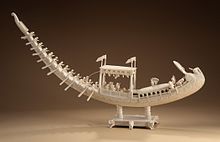Bishnupur gharana
| Part of a series on the |
| Culture of Bengal |
|---|
 |
| History |
| Cuisine |
 | ||||||
| Music of West Bengal | ||||||
| Genres | ||||||
|---|---|---|---|---|---|---|
|
||||||
| Specific forms | ||||||
|
||||||
| Media and performance | ||||||
|
||||||
|
|
||||||
| Regional music | ||||||
|
||||||
The Bishnupur gharana (alternatively spelt Vishnupur gharana) is a form of singing that follows the dhrupad tradition of Hindustani music, one of the two forms of Indian classical music.[1]
History
The gharana originated in Bishnupur, West Bengal, India in the late 18th century with its roots dating back to the 13th-14th centuries CE.[2] The name of the town means "city of Vishnu" in Bengali. In the ancient past, this area, known as Mallabhum was the abode of Malla Kings who were vassals to the Mughal Empire and were devotees of Vishnu and patrons of music. Historians suggest that 'Mallabhum' had once been the cultural centre of Eastern India.[3] It also has the distinction of being the only vocal gharana in West Bengal.

In the 17th century, during the reign of Mughal emperor Aurangazeb, many musicians moved to the court of the Maharaja of Bishnupur who was a known patron of the arts.[4] The dhrupad singer Bahadur Khan of the Senia gharana, descendant of Tansen, fled to Bishnupur and made his gharana popular and sought refuge in the court. Bahadur Khan was not only a vocalist but could also play the Veena, the rabab, and the surshringar. The king, Raghunath Singh Deo II, accepted him as a court singer. In time, a good number of students became the disciples of Bahadur Khan.
Historical evidence points to Ramasharan Bhattacharya, a disciple of Bahadur Khan as the founder of the gharana.[5] Bishnupur Gharana therefore has a strong link to Betiya Gharana through this unbroken relationship. However, this view is contradicted by some historians, who claim that Bahadur Khan could not have attended the Durbar of King Raghunath Singh Deo II because of anachronism, as there is a gap of at least 50 years (2 generations) between them. In practice, Bishnupur Gharana has got some characteristic features in the improvisations of some Ragas which are different from the practice of the Betiya school of the Seniya gharana. [6] [7]
Style of singing and Ragas
In this style, the artist elaborates on the raga through the alap in a simple fashion, devoid of ornamentation. It is free from intricate play with the rhythm. Layakari is however allowed in Dhamar, another form of vocalisation. The khyal of the Bishnupur gharana is noted for its sweet, lilting melody. It is adorned with the usual ornaments, which add variety to the melodic presentation of the raga.
Its origins and development have led to a great openness in the teaching and evolution within this gharana.[8]
This gharana has the ragas , many of them are now very popular by their names, but their notes and chalans are different. For example this gharana's Purvi, Sohini, Shyam, Bibhas and many many more ragas with popular names have different notes and chalans. The Sohini, Purvi, Bibhas, Shyam , used by Rabindranath Tagore, are from this gharana. Because, his gurus-Jadu Bhatta, Bishnu Chakraborty belonged to this gharana.
The Bishnupur gharana tree[9]
| Bahadur Khan | |||||||||||||||||||||||||||||||||||||||||||||||||||||||
| Gadadhar Chattopadhyaya | |||||||||||||||||||||||||||||||||||||||||||||||||||||||
| Ram Shankar Bhattacharya | |||||||||||||||||||||||||||||||||||||||||||||||||||||||
| Ramkeshab Bhattacharya | Keshablal Chakraborty | Kshetra Mohan Goswami | Anantalal Bandopadhyay | Jadunath Bhattacharya | |||||||||||||||||||||||||||||||||||||||||||||||||||
| Radhika Prasad Goswami | Ramprasanna Bandopadhyay | Gopeshwar Bandopadhyay | Surendranath Bandopadhyay Padma Shri (1972) | Ambika Charan Bandopadhyay | Bipin Chandra Chakraborty | ||||||||||||||||||||||||||||||||||||||||||||||||||
In popular culture
Film
- Eastern Zonal Cultural Centre, Kolkata, brings you the Fourth Documentary from 𝗢𝗻𝗹𝗶𝗻𝗲 𝗔𝗿𝗰𝗵𝗶𝘃𝗲 𝗗𝗼𝗰𝘂𝗺𝗲𝗻𝘁𝗮𝗿𝘆 𝗙𝗶𝗹𝗺 𝗙𝗲𝘀𝘁𝗶𝘃𝗮𝗹. The video is a presentation on the dhrupad gharana of Bishnupur kingdom in West Bengal.
References
- ^ M. Ganguly (7 May 2008). "Sweet tributes to music". The Telegraph. Archived from the original on 19 July 2013. Retrieved 19 July 2013.
- ^ Samira Dasgupta; Rabiranjan Biswas; Gautam Kumar Mallik (2009). Heritage Tourism: An Anthropological Journey to Bishnupur. Mittal Publications. pp. 110–. ISBN 978-81-8324-294-3. Retrieved 19 July 2013.
- ^ Ghoash, P (2002). "Tales, Tanks, and Temples: The Creation of a Sacred Center in Seventeenth-Century Bengal". Asian Folklore Studies. 61 (1): 193–222. doi:10.2307/1178971. JSTOR 1178971.
- ^ SinhaThakur, Debabrata (1970). Bishnupur Gharanar Utpatti Itihas. Bharabi, Bankura. p. 88.
- ^ Capwell Charles (1993). "The interpretation of history and foundations of authority in Visnupur Gharana of Bengal". Ethnomusicology and Modern Music History (Ed.) Stephen Blum, Daniel M. Neuman. University of Illinois Press: 95–102.
- ^ "Dhrupad Gharanas in North Indian Classical Music". ITC Sangeeth Research Academy. Archived from the original on 22 April 2009. Retrieved 1 June 2009.
- ^ Bharatiya Sangite Gharanar Itihas. Dilipkumar Mukhopadhyaya. Published by A. Mukherjee & Sons. Calcutta
- ^ Owens, Naomi (1969). Two North Indian Musical Gharanas (M.A. Thesis). University of Chicago.
- ^ "Bishnupur Gharana | By Anjan Ganguly". www.geetabitan.com.
Further reading
- Capwell C., 1993. The interpretation of history and foundations of authority in Visnupur Gharana of Bengal., in Ethnomusicology and modern music history, By Stephen Blum, Daniel M. Neuman Ed., University of Illinois Press, 1993., ISBN 0-252-06343-0, ISBN 978-0-252-06343-5, pp 95–102
- Sengupta, P. K. 1991. "Foundations of Indian musicology: perspectives in the philosophy of art and culture", Abhinav Publications, Calcutta, ISBN 81-7017-273-X.

